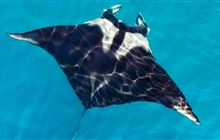The ocean's gentle giants make welcome appearances this summer
Archived content: This media release was accurate on the date of publication.
Introduction
Manta rays – gentle giants of New Zealand’s seas – are making increasing appearances this summer as DOC and Manta Watch NZ urge people to report sightings of the rare, huge fish.Date: 27 January 2022
From December 2021 to January 2022 Manta Watch NZ received 99 reported manta ray sightings, concentrated in the Bay of Islands, the Hauraki Gulf, Mercury Island, the Alderman Islands and the Bay of Plenty.
Department of Conservation (DOC) Marine Technical Advisor Clinton Duffy says any sightings of manta rays contribute to research efforts and build long-term sightings data records.
“There is a significant population of oceanic manta rays near Aotearoa that we are still trying to understand, but their highly elusive nature means they can often go unnoticed.
“Not many people know we have manta rays around our coastlines and it’s important people understand what to do if they spot one.
“Reported sightings of manta rays can help in our efforts to monitor and assist in the conservation of these creatures.”
Manta Watch NZ (MWNZ) Director Lydia Green says over the last four years a lot of effort has gone into raising awareness about Aotearoa’s manta rays, and citizen science submissions directly contribute to our research as well as help focus our dedicated survey efforts.
“Historically we've had sightings from September through to June, however ocean goers are most likely to see manta rays in summer, from December to February. During this time mantas spend a lot of time on the surface actively feeding on krill swarms, making them a lot easier to spot.
“Every manta has a unique spot pattern on its belly, much like a human's fingerprint, and cataloguing these ID images enables MWNZ researchers to build population estimates and track individuals over time.
“If you spot a manta ray, take a photo and/or video. Even better if you can get a shot of their belly region. Researchers can learn so much more from images and videos, so trying to record your manta ray encounter is a massive help. And record additional key info including, date, time and GPS position of your sighting.”
Oceanic manta rays can reach seven metres across and weigh 2000 kg. Known for their curious nature, these highly intelligent creatures have worldwide distribution, inhabiting both tropical and temperate waters. Aotearoa is the most southern part of the species’ range.
Giant manta rays have a very conservative life history and are slow growing, reach sexual maturity in their teens and have a low birthing rate of only one pup every other year or so. This means they have low resilience to fishing pressure. They are also protected under the Wildlife Act 1953. It is illegal to hunt, kill or harm manta rays within New Zealand’s national waters.
If you see a giant manta ray or devil ray, report it to DOC by emailing sharks@doc.govt.nz.
You can also support citizen science by reporting giant manta ray sightings to MWNZ. Email mantawatchnewzealand@gmail.com and/or fill out their online sightings form.
Background information
Giant manta rays (Mobula birostris) have huge, diamond shaped bodies and swim by beating their 'wings' up and down together. They can also beat them in opposite directions – one up, one down.
Although once thought to migrate seasonally to the waters around northern New Zealand, research on other populations in the Indo-Pacific region suggests that the giant manta ray seen in our waters during spring and summer each year may be resident in this part of the southwest Pacific.
Although manta rays are considered harmless, as they do not have barbs on their tails like their distant cousins the stingrays and eagle rays, these gentle giants should be observed at a respectful distance, as with all wildlife. Their inability to swim backwards makes them vulnerable to becoming tangled in ropes and fishing equipment.
Contact
For media enquiries contact:
Email: media@doc.govt.nz

